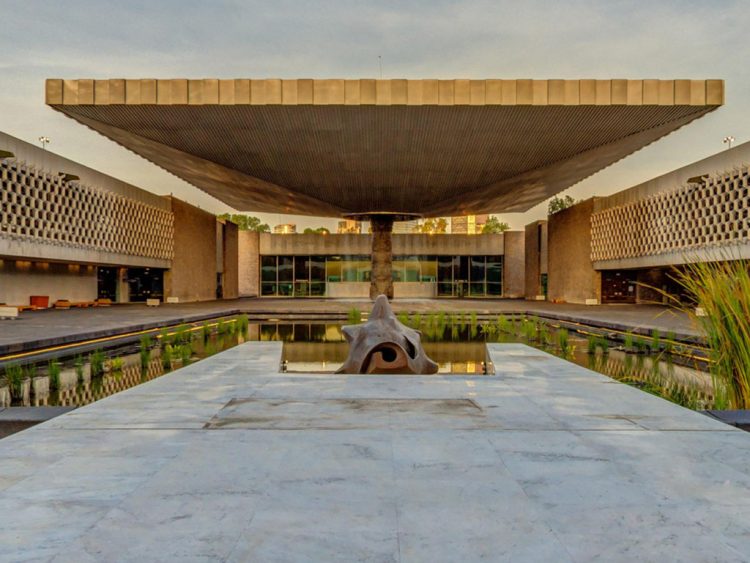
Image courtesy of the Instituto Nacional de Antropología e Historia de México.
Thousands of years of culture and artistry hide behind the Brutalist facade of the Museo Nacional de Antropología.
You could say that it’s impossible to truly understand contemporary Mexican design without a visit to Mexico City’s Museo Nacional de Antropología. Opened in 1964 on the outskirts of Chapultepec Park, the museum showcases a collection of important objects whose origins span epochs of the region’s history, from ancient to pre-Columbian, rediscovered over the past three centuries and arranged by era to promote engagement, education, and cultural identity.
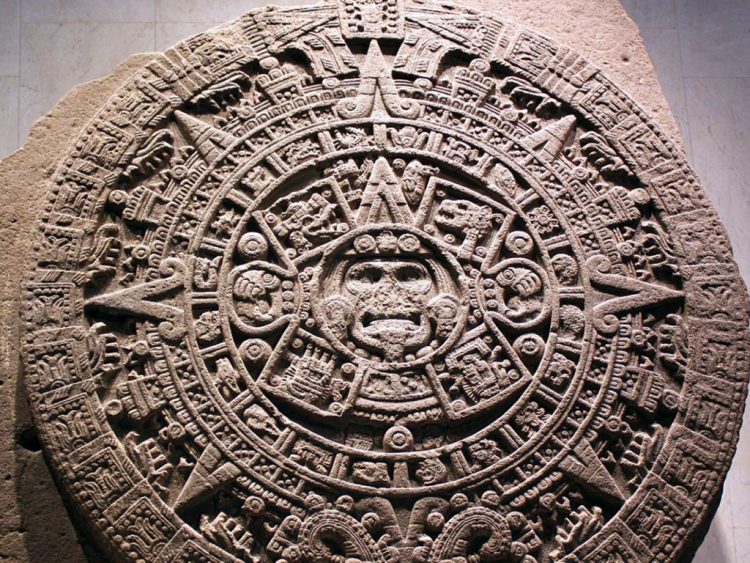
The Mexica Piedra del Sol (sun stone), pictured above, was carved in the late 15th or early 16th century. The stone was removed and buried during the Spanish conquest.
Indeed, to first-time visitors, the sheer volume of works in the museum may seem daunting: The museum’s lower floor highlights pre-Hispanic cultures; directly above each group on the upper level, corresponding galleries explore how each civilization’s Indigenous descendents live today. One of the most famous artifacts in the museum is the 25-ton Piedra del Sol, a Mexica-era sunstone unearthed in the zócalo in 1790 during repairs to the local cathedral. The sculpture was prominently displayed on the cathedral facade until it was transferred to a gallery more than a century later, inspiring outcry over its removal from the public sphere.
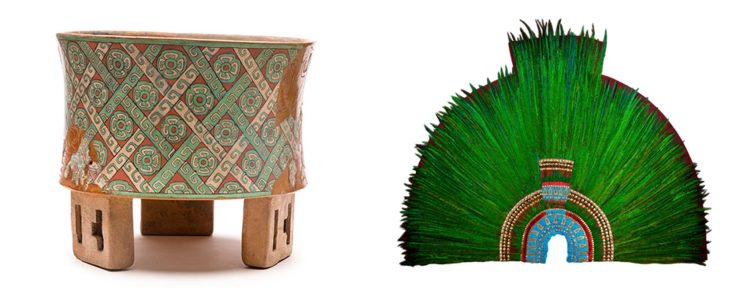
Two artworks from the collection of the Museo Nacional de Antropología. Left: A stucco vase from the Xolalpan-Metepec period between 400 and 750 CE. Right: A 1940 replica of a ceremonial artifact popularly (although not necessarily accurately) attributed to Motecuhzoma II. The original piece is housed, controversially, in the Weltmuseum Wien in Vienna. Images courtesy of the Museo Nacional de Antropología.
Other notable objects in the collection include a five-and-a-half foot tall Olmec colossal head dating back to at least 900 BCE and the jade death mask of an ancient Mayan king. Newer artworks, including murals by Rufino Tamayo and Leonora Carrington, speak to the continued relevance of Indigenous identity in modern Mexico.
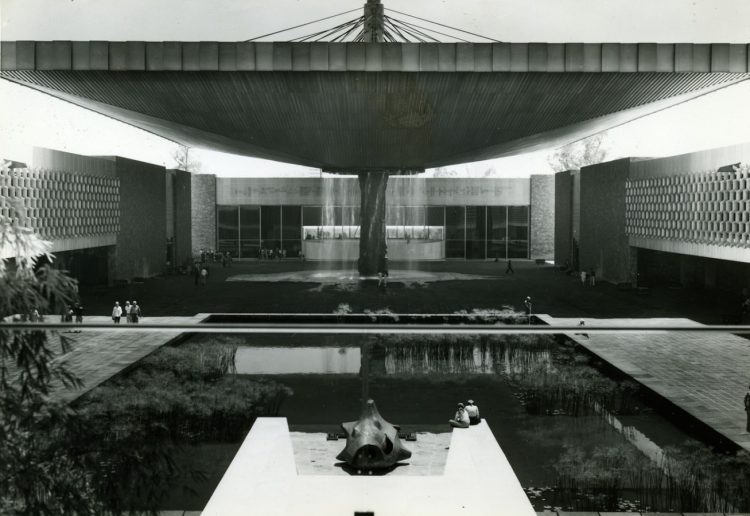
Architect Pedro Ramírez Vázquez chose to construct the museum out of stone to emulate the country’s historic temples. Image by Constantino Reyes-Valerio, courtesy of the Instituto Nacional de Antropología e Historia de México-Fototeca.
Although the vast collection provides enough reason to visit, for design lovers, the culturally significant Brutalist architecture is nearly as enticing—and it tells an equally important tale of Mexican history. Development of the museum began during the administration of Mexican President Adolfo López Mateos, with the intention of gathering Mexico’s archaeological treasures under one roof. To comprehensively reflect the mission of the museum, the architecture needed to take inspiration in the country’s striking heritage, while incorporating contemporary concepts of beauty.
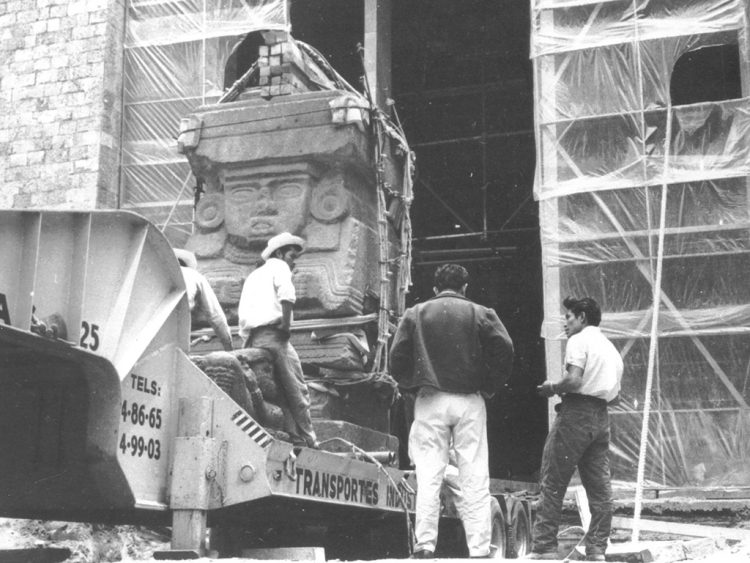
During its construction, the new Museo Nacional de Antropología posed logistical challenges: Teams needed to move fragile, unwieldy artifacts from distant regions to Mexico City. Two cranes were required to install this statue of Chalchiuhtlicue, a Mexica deity, at the museum. Image courtesy of the Museo Nacional de Antropología.
Pedro Ramírez Vázquez, a Modernist architect born in the final years of the Mexican Revolution, was tapped to helm the museum’s design. Eschewing traditional European museum floor plans with large rooms that could overwhelm viewers, Ramírez Vázquez looked instead to references within Mexico’s rich archaeological history. Cuadrángulo de las Monjas, a ninth-century architectural triumph on the Yucatán Peninsula, greatly influenced his development of the design. Reminding some viewers of a convent, the heritage site features four platformed structures that surround a central courtyard. Ramírez Vázquez translated the Cuadrángulo’s influence into a contemporary design featuring varied concrete and metal structures coiled around an interior outdoor space, with each building inviting a different spatial experience. He covered a portion of the outdoor area with a roof so that museum visitors could travel through the tranquil courtyard between exhibitions, regardless of rain.
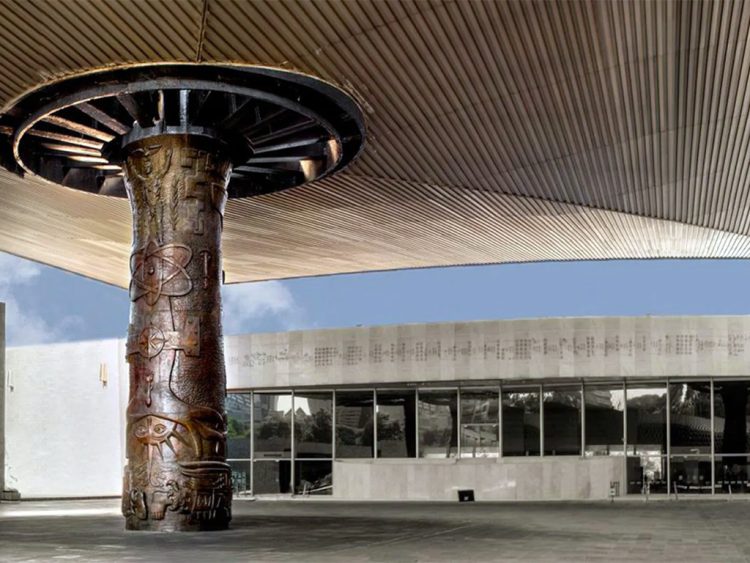
The Morado brothers, who designed and carved the column, were also responsible for other artworks on the campus, including a relief on the exterior entrance by José Morado. Image courtesy of Museo Nacional de Antropología.
Throughout the project, Ramírez Vázquez relied on a team of highly skilled architects, artists, and artisans, including painter and sculptor Manuel Felguérez Barra—a peer of Diego Rivera—who assembled the metal latticework symbolizing Mexico as it evolved from, and continues to evolve, along Indigenous roots. For an interior column fountain, playfully dubbed el paraguas (the umbrella), he commissioned artists José and Tomás Morado, who designed and carved the column’s reliefs depicting Mesoamerican cosmological themes.
The museum represents Ramírez Vázquez’s legacy as an architect who helped merge two worlds, the past and present, to forge modern Mexican identity. Despite resounding praise, the design, once completed, also found critics: In 1969, in the midst of widespread anti-government protests, poet Octavio Paz argued that the museum design gave outsized importance to the Mexica within Mexico’s heritage (when the country’s history had included numerous great civilizations) to present authoritarian rule as historically inevitable. By 1969, the Institutional Revolutionary Party that had inaugurated the museum had held uninterrupted power for 40 years; it would continue to dominate Mexican politics until 2000.
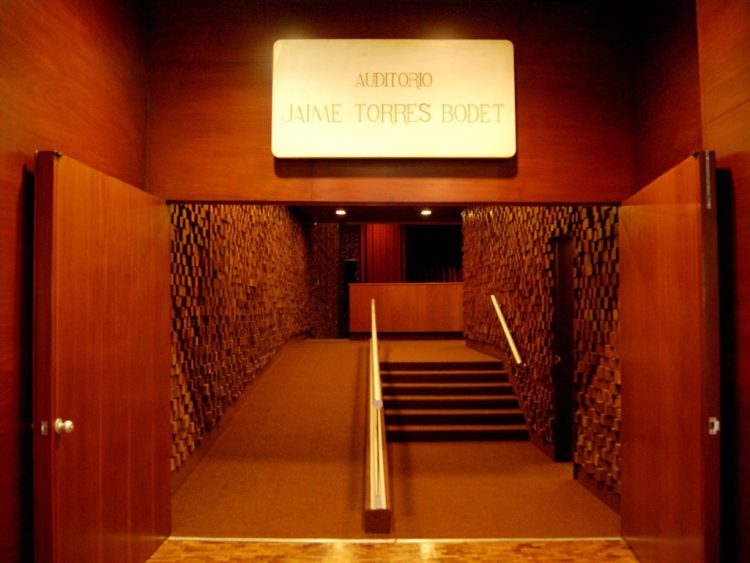
The Jaime Torres Bodet auditorium, where the General Sessions at the Design Leadership Summit will take place. Image courtesy of the Instituto Nacional de Antropología e Historia de México.
Enter the museum today via the esplanade, and you’ll find that the galleries are not necessarily the most obvious rooms to explore first. Research spaces, classrooms, and an auditorium—where the DLN General Sessions will take place—border the entrance hall, suggesting that the museum is a working space dedicated to the preservation and development of culture, rather than a tourist attraction.
With a long backstory and likely a longer future, the Museo Nacional de Antropología demonstrates that Mexican history is ever-evolving, and how we interpret it shapes modern life, moment by moment.